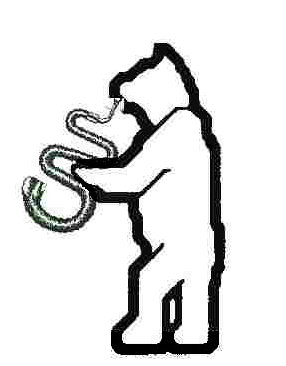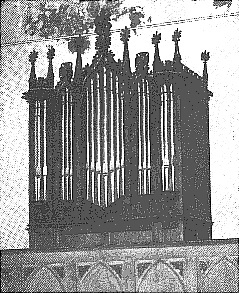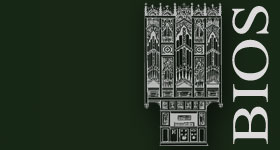 |
Barrel organs - 2 |
|
|
Experiences with Barrel organs
Juhn Budgen
Article reproduced from the BIOS REPORTER, April 1997, Volume XXI, No.2 Rather over forty years ago, Canon Algernon Wintle was to be
found playing street pianos for charity in Bury St Edmunds. A
radio broadcast led to a succession of small barrel organs being
sent to him for repair - he in turn consulted us for the organ
parts. Our experiences with successive barrel organs repairs
were varied. The smallest, cigar-box size, had spaces for eleven
(missing) pipes, nd we deduced the actual compass as rhythm and
melody emerged. The 'Serinettes' were little table models, said
to have been popular for encouraging the efforts of songbirds;
there were larger drawing-room organs set on a stand with two
barrels, one stored while the other was in use. They usually had
nineteen notes, most tunes were in G or D major; I cannot recall
ever seeing an F or an A sharp, and DD and GG were included
sparingly; minor tunes were rare. A few hymn tunes were
included, Adeste Fideles being the most frequent. The Reading University Music Department barrel-organ is a 'chapel-sized' instrument, some way short of a full church instrument. On a low plinth, its barrels in a box held with a slide for security, it has twenty three notes from Tenor D to Treble G, with an inevitably light bass line. It is a church instrument, including one chant (Mornington) and this raises an interesting problem. Up to this size, such organs are blown by the turning handle and two pairs of 'cuckoo feeders'; pausing on a reciting note stops the wind supply with lamentable results; psalmodic barrel organs had a separate blower to overcome this.
The Bryceson barrel organ at Shelland, Suffolk, has been in
continuous use since installation; unusually it has a tierce.
When I attended service, I stood up at the front of the
congregation for the first line of Shirland and was 'left
standing' while the rest of the tune played its majestic course.
Currently, the parishioners at Shelland are preparing an order
for a new barrel, perhaps demanding tunes which are not
harmonically available. Many organ-builders produced barrel-organs on commission.
J.C. Bishop produced such miniature organs while becoming
established; music houses such as Keith Prowse, the longman
partnerships and others out their own names on organs without
any trace of the actual makers. In the church field, Flight &
Robson were prolific, as was Bryceson, closely followed by
Bevington, Walker, Bates, Gray and Forster & Andrews. Most came
from London, although there were provincial examples. Some important distinctions arise between makers' uses and
the types of organs. Walker and Gray mounted their three barrels
in iron hoops ( a form of carousel, as pointed out by
Christopher Turner) and this means no more could be added
without great difficulty. Bryceson and most of the others set
the barrel in a cradle which could be slid into position.
Barrels are not usually interchangeable between organs, and care
is needed when changing a barrel to ensure correct alignment.
The 'barrel and finger' organ had the virtue of providing an
invaluable live deputy organist to the one barrel, and a full
chromatic compass - its size usually permitted twelve tunes to
be pinned rather than ten. Two examples by bishop survive in
working order, apart from his huge barrel at Churchill, with its
interesting 'local' tune, Sarsden; I promised the vicar
in 1958 that I would transcribe it. The other device is the 'dumb organist'. This is a barrel
attachment with 'fingers' (stickers) which press on the keys.
Lamentably. a dumb organist was put on a bonfire at, above all
places, Little Cornard, only twelve years ago. Bates provided
dumb organists and several of his are still playable e.g. Tadlow,
and soon, Lillington in Somerset. The rapid rise in keyboard playing led to an almost
vindictive sidelining of the barrel organs (many parishes might
wish they had them back now) and to their destruction. Their
incomplete scale militated against conversion to finger organs;
others saw their pipes incorporated into new instruments e.g. at
Church Knowle, within living memory. Some we have rescued from ruinous condition and kept them up
year by year; this was discontinued at Hutton after much
fundraising had seen the organ back in use as the vicar 'was not
paid to keep a museum'. Museums have little better to say for
themselves - at Leicester, Cardiff and Bradford they have set
about ruining their restored organs by placing them against
radiators. The Bradford organ by Lincoln was particularly
interesting with a spiral barrel playing a lengthy and manually
exhausting concerto by james Hook. Some remain in good order and much appreciated; the Steeple organ is used at every service, whether for singing or voluntary. (We had nothing to do with the design of the protective cage around the organ; funds are being raised for a proper case.) Registered charity no. 283936 |

